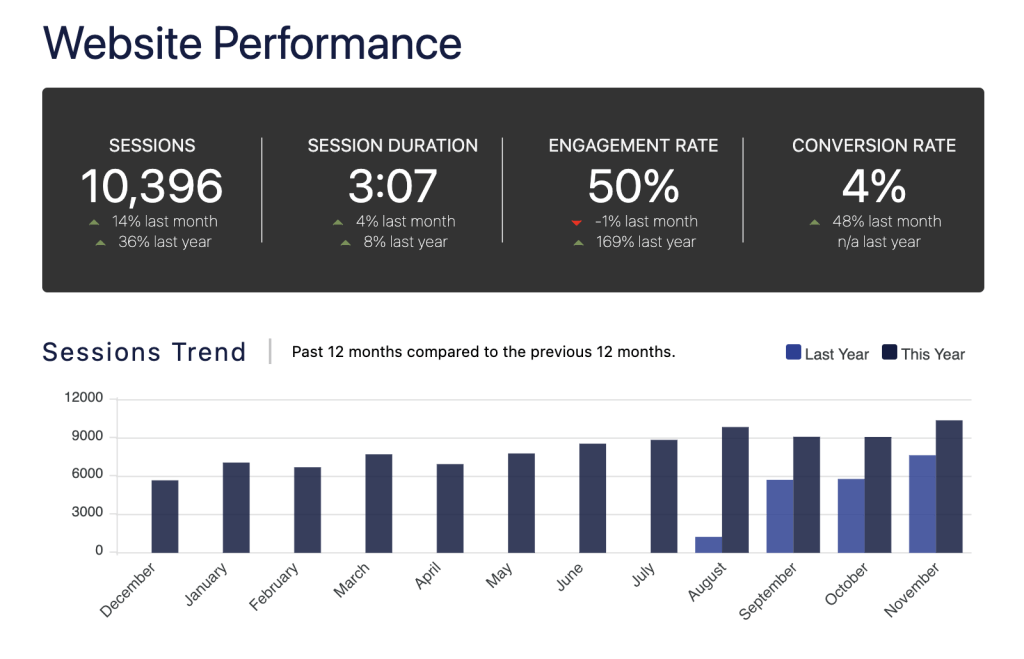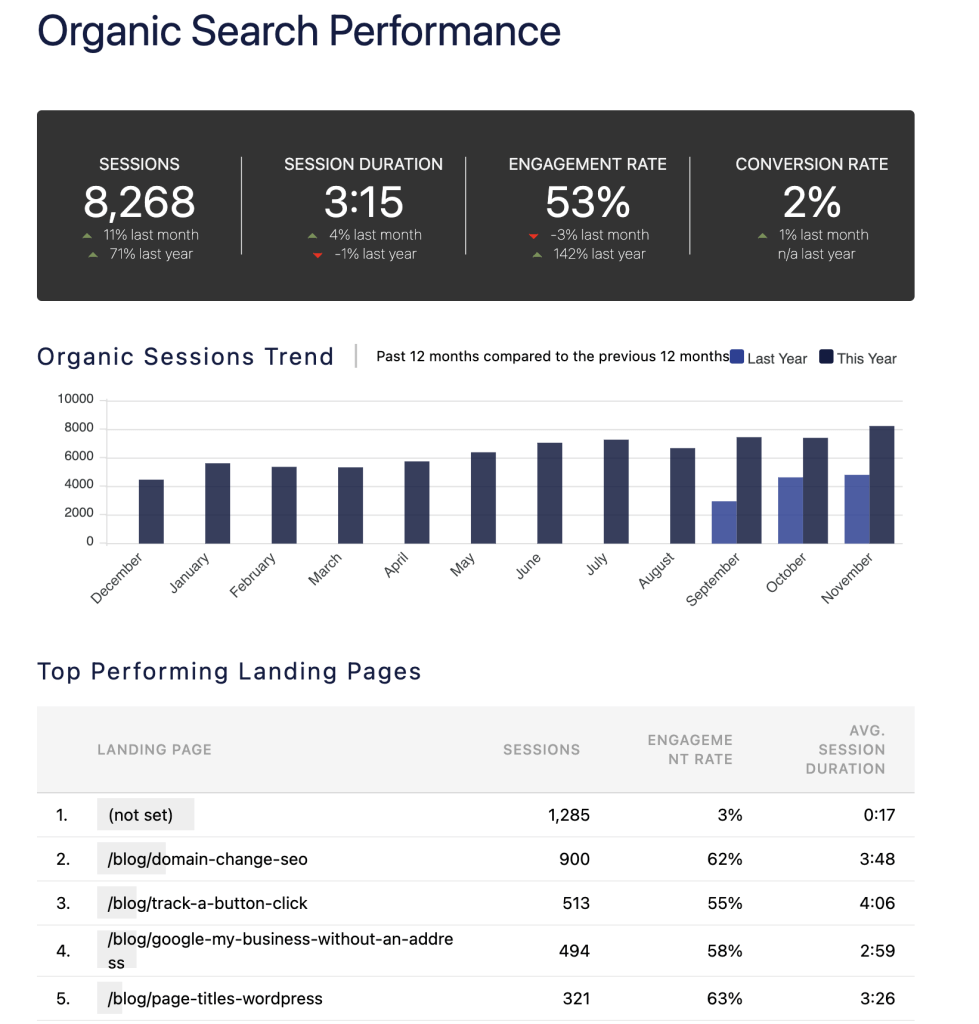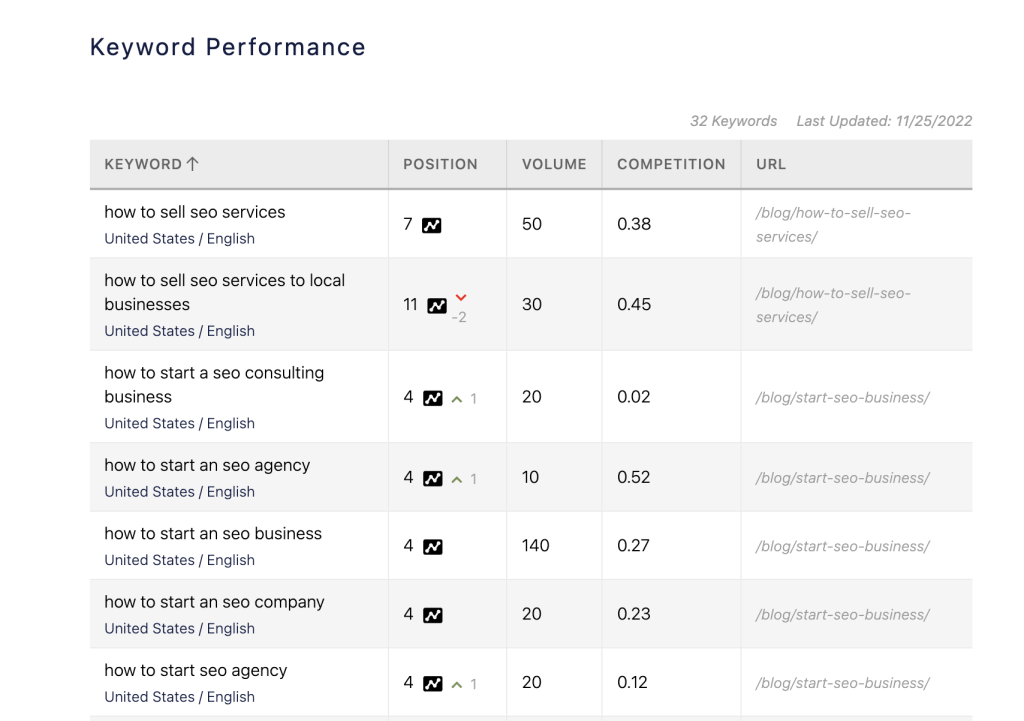Monthly SEO reports are a key component of ongoing SEO services as they:
- Fulfill your client’s expectations. Most clients expect monthly reports as part of any ongoing SEO services. It’s an industry best practice.
- Keep lines of communication open. By sharing your insights on the campaign performance data, you ensure your client understands the results even if they are too busy for a call.
- Inform your overall strategy. You can’t manage what you don’t measure. Reviewing the client’s monthly results ensures your action items are targeted for the greatest strategic impact.
- Build trust. By communicating the performance of your SEO campaign, you build a partnership with your client based on trust. This increases the value of your services.
Now that you know why monthly reporting is valuable, let’s explore what to include and how to generate monthly SEO reports.
What to Include in Monthly SEO Reports?
Google Analytics is the core data set that powers a monthly SEO report. It provides insights into the session volume, visitor engagement, and key performance indicators (conversions).
This can be supplemented with rank tracking data from SEO software so your client can follow along with progress in improving the keyword visibility on Google. Some monthly SEO reports also include data from the Google Search Console and Google Places for Business.
When building a monthly SEO report, a logical flow of the data helps to make it digestible. Breaking the report into three sections and placing the most important data at the beginning of the report supports this flow.
Section 1: Web Performance Overview
Frame the performance of organic search alongside other marketing channels like direct traffic, Google Ads, email, and referral, focusing on comparing to the previous month or year, depending on the client’s target time range. Also, showcase key performance indicators or conversion rates to speak to what matters in web performance — lead generation and sales.

Section 2: Organic Search Performance
Segment the next section of the report to hone in on organic search as an individual marketing channel. Look at historical trends and summarize the performance of the key landing pages leading to organic visitors.

Section 3: Keyword Performance
Conclude the report with supportive data such as rank tracking data. This section can be a leading indicator of success whereby you see an improvement in the rankings before your client sees the increase in traffic.

How to Create a Monthly SEO Report
Two primary methods exist to create a monthly SEO report — manual and automated. With a manual approach, you take screenshots of data from multiple sources and compile a report. This is time-consuming, tedious, and is also prone to error.
Instead, automation saves time and improves data accuracy. There are several monthly SEO reporting software that support this effort. Each has its strengths. Determine what best suits your agency’s requirements and invest in the best software for you and your clients.
What is the Best Automated SEO Report Tool?
When selecting an automated SEO reporting tool for your agency, there are several key considerations, including:
- Ease of setup
- Customizability
- Price
- Third-party data integrations
Here’s an overview of the best automated SEO reporting tools:
Google Looker Studio
A free software, Google Looker Studio supports the creation of a highly customizable report template for your agency with connections to multiple data sources. There is endless flexibility, which is an advantage. Unfortunately, that also comes with a steep learning curve and a high time commitment. Google Looker Studio is best for agencies that serve medium to large businesses on retainers of $1,500/month or more.
Pathfinder SEO
Via integration with GA4 and built-in rank tracking, Pathfinder creates white-labeled monthly SEO reports delivered to your inbox each month. They are simple and easy for clients to digest by focusing on the data that matters. They require very little time to set up. Pathfinder’s reports are best for agencies that serve small to medium-sized clients on retainers of $300-$1,500/month.
AgencyAnalytics
A paid software that is focused on white-label reporting for agencies. AgencyAnalytics features many data integrations and templated reports to help jumpstart your efforts. While easier to learn than Google Looker Studio, creating the initial report for your clients is still a time commitment. AgencyAnalytics’ reports are best for agencies who service medium to large-size clients on retainers of $1,500/month or more.
Monthly SEO Reporting Process for Agencies
With reporting being a key component of your SEO services offering that you include monthly, you'll want to create a standard process so your team can easily deliver monthly SEO reports and scale.
A process for monthly reporting includes:
- Analyze the data. Review the automated report to get a sense of the trends. What data do you want to feature in your written summary for the client? What data requires more investigation? Can you tie any of the results to recent action items? For example, improved keyword rankings on a blog post you revised and improved on the client's website.
- Explore any significant shifts or trends to understand the why. This may require opening Google Analytics and/or the Google Search Console. With SEO, there aren't always singular reasons why the results are what they are. For example, external factors outside your control may be at play, like a shift in market demand causing an increase or a decrease in traffic. Alternatively, Google's algorithms may have evolved to favor your client's content.
- Write a summary of the data. Draft the content for an email to the client to deliver the monthly report. Include a mix of quantitative data with a qualitative summary so those clients who aren't comfortable with numbers still get value from your write-up.
- Update the monthly action items based on any insights from the report. This is the project management component of monthly reporting. Determine what tasks will be completed this month and assign them to the proper team member.
- Email the report to the client, including your summary. Export your client's report as a PDF and attach it to an email with your written summary.
Frequently Asked Questions
How much time should I spend on monthly SEO reporting?
Creating the physical report each month should only take a matter of seconds via an automated approach. The time investment comes in analyzing the data and email summary for the client. This process takes 30 minutes to 1 hour for small to medium-sized businesses and 1 to 2 hours for large to enterprise clients.
Do clients even open their monthly reports?
Some SEOs question the value of monthly reporting because they doubt their clients open the reports. That may be true sometimes, but the value is still there. The client will have your monthly reports as a reference if they ever call into question your monthly action items and the results. They are also likely to read the report summary in the body of the email, even if they don’t download the PDF. And finally, you, as an SEO account manager, need to be on top of the data so you can proactively and strategically manage the account.
Managing Monthly SEO
SEO reports are part and parcel of the larger skill of managing monthly SEO for your clients. This is part art and part science.
At Pathfinder SEO, we provide our agency customers with a business system to master managing monthly SEO. This starts with creating monthly packages and getting the pricing right. Then, we help you market and sell the service. And most importantly, we streamline the delivery of SEO services.
Our SEO services system includes these resources and tools to make managing monthly SEO easier and more profitable for agencies:
- Monthly SEO task roadmaps. This project management resource lays out tasks for months 1 - 12 of an SEO services offering.
- Email templates for delivering monthly SEO reports. Leverage these templates to standardize your monthly SEO reporting process.
- Process documentation for monthly SEO tasks. Enable junior team members to provide tactical support to complete monthly action items.
- Workshops to master the skills of monthly SEO reporting, monthly SEO project management, and more.
- Group coaching to get your questions answered. We go further, faster together.
Schedule a demo to learn more.